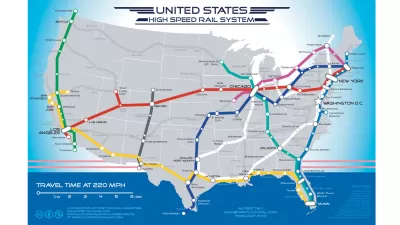High-speed rail is not an $11-billion failure, as a recent New York Times article asserts, writes Time's Michael Grunwald. A more appropriate name would be "higher speed" rail as outside of the California project, all are upgrades of Amtrak lines.
Furthermore, it's way too early to judge, according to Grunwald. "(O)nly $2.4 billion of it has been spent to date, much of it on planning, design and other pre-construction work. The big construction spending has just started, and will continue through September 2017," he writes.
The August 6 article Grunwald attacks, "$11 Billion Later, High-Speed Rail Is Inching Along," by Ron Nixon, "fuels widespread public misperceptions about what the program has already achieved," writes Grunwald. he public debate over the program has been almost completely detached from the reality on the ground."
"As I wrote a few years ago in TIME, it was partly about creating new routes for 200-mile-per-hour bullet trains like the ones already zipping around Europe and Asia, but it was mostly about improving slower-speed Amtrak routes so they would be incrementally faster and more reliable," writes Grunwald. Of the former category, only one project remains, of which we may have posted too many stories.
The other high speed project was terminated "after Rick Scott, a Tea Party Republican, was elected governor of Florida in 2010. (H)e killed the Sunshine State’s Tampa-to-Orlando-to-Miami train and sent $2.4 billion back to Washington," writes Grunwald. [Also posted here.]
OK - so where was the rest of the $2.4 billion directed? Grunwald lists no shortage of upgrades to conventional Amtrak corridors and stations.
By 2017, the program will reduce trip times from Chicago to St. Louis by nearly an hour through upgrades that will increase top speeds from 79 to 110 miles per hour; Chicago to Detroit will get a similar boost. The Department of Transportation says it has already sliced off a half-hour between Springfield, Mass., and St. Albans, Vt., while completing projects to reduce delays around San Jose, San Diego, Fort Worth and Oklahoma City. It has extended Amtrak service for the first time to Brunswick, Maine, anchoring a thriving downtown revitalization program, and it’s bringing trains to the Illinois towns of Geneseo and Moline for the first time since 1978.
The New York Times editorial board also commented on Nixon's piece, but only took aim at Congress, as does Grunwald, which is unwilling to support President Obama's commitment to high and higher speed rail. "Once Republicans took over the House, Congress stopped appropriating money for high-speed rail. Period," writes Grunwald.
[Hat tip to Politico's Adam Snider for including Time article in his "RANDOM TRIO OF TRANSPO HEADLINES" in the August 12 Morning Transportation.]
FULL STORY: The Truth About Obama’s High-Speed Rail Program

Maui's Vacation Rental Debate Turns Ugly
Verbal attacks, misinformation campaigns and fistfights plague a high-stakes debate to convert thousands of vacation rentals into long-term housing.

Planetizen Federal Action Tracker
A weekly monitor of how Trump’s orders and actions are impacting planners and planning in America.

In Urban Planning, AI Prompting Could be the New Design Thinking
Creativity has long been key to great urban design. What if we see AI as our new creative partner?

King County Supportive Housing Program Offers Hope for Unhoused Residents
The county is taking a ‘Housing First’ approach that prioritizes getting people into housing, then offering wraparound supportive services.

Researchers Use AI to Get Clearer Picture of US Housing
Analysts are using artificial intelligence to supercharge their research by allowing them to comb through data faster. Though these AI tools can be error prone, they save time and housing researchers are optimistic about the future.

Making Shared Micromobility More Inclusive
Cities and shared mobility system operators can do more to include people with disabilities in planning and operations, per a new report.
Urban Design for Planners 1: Software Tools
This six-course series explores essential urban design concepts using open source software and equips planners with the tools they need to participate fully in the urban design process.
Planning for Universal Design
Learn the tools for implementing Universal Design in planning regulations.
planning NEXT
Appalachian Highlands Housing Partners
Mpact (founded as Rail~Volution)
City of Camden Redevelopment Agency
City of Astoria
City of Portland
City of Laramie



























